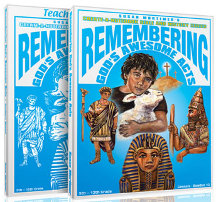More limited in scope than most unit studies, both volumes of the Bible and Ancient History: Create-a-Notebook Series unit study focus primarily upon Bible and history. They also provide some coverage in art, writing, speech, drama, geography, social studies, linguistics, anthropology, and archaeology. Each course should take a year to complete and should translate into a credit for a Bible/religion course plus partial credit in other subject areas.
Volume 1: Remembering God's Awesome Acts
The eight units in the first volume deal with creation, man, the fall, the flood, the dispersion, God's chosen people, Egypt, and the Exodus. Each unit integrates Bible study with historical/cultural studies as the foundation. History and social studies cover historical data about the Sumerians, Babylonians, and Egyptians in a somewhat random fashion, but religious beliefs are highlighted and often examined in great depth. Lessons at the beginning of the book coupled with these on non-Christian belief systems and mythology provide a strong introduction to world views upon which we can continue to build through the high school years.
From history and Bible-based lessons, the course branches out to activities in the other subject areas, all still related to the primary theme of each unit. Brief instructions for each lesson are given in the teacher's manual, but most of each lesson is derived from and requires the student notebook. The pages in the student notebook serve as sources of information and activity pages/worksheets that become a "permanent" notebook when the course is complete. These heavily illustrated pages offer a great deal of variety and visual interest. Each student will need his or her own notebook.
The course is suggested for grades five and up. While some of the content is introductory level, much of it is challenging enough for junior high and, possibly, even the beginning of high school. However, even when the content is challenging, many of the activities seem a little young for junior high students. There is good bit of cut-and-paste, coloring, puzzles, filling in the blanks with words from a word bank, and other such activities more typical of the elementary grades.
Three subject areas deserve special mention. Drawing exercises interspersed throughout the book teach basic shapes, shading, drawing from life, drawing faces, and perspective, although instruction on each of these skills is very limited. Linguistics receive a great deal of attention in the unit on the dispersion from Babel. Students are exposed to a number of different languages and dialects (e.g., Turkish, Waroni [Ecuador], Vietnamese). Languages are approached in the context of country studies drawing on the book Operation World. You might expand this section beyond those countries for which studies are provided, following the models used for those lessons. Speech and drama activities require students to present orally before groups. To make this easier for them to do, scripts for Bible stories/teachings that use "object lessons" are provided within the teacher's manual. You, the parent/teacher, first presents each lesson to your student(s), then they are to familiarize themselves with the script and props and present the lesson to a Sunday School class, a backyard Bible study, or other appropriate audience. This is a wonderful way for our children to learn the value and basic skills of public speaking.
While this study includes sufficient Bible study, you will probably want to use it in conjunction with a text or other resources for more thorough history coverage. For other subject areas it is supplemental. Lesson preparation is fairly minimal, but you must look over lessons ahead of time in case you need to gather any books or materials. Lesson presentation time will vary from day to day; you can often expand or contract lessons as you choose. Students will complete parts of most lessons on their own. The NIV Bible is used; using other versions will require minor adaptation on some activity pages.
Vol. 2 - Remembering God's Chosen Children
The second volume picks up where the first left on, beginnng with the Exodus from Egypt and continuing up through the reign of Solomon. There's a bit more content in this book although it should still take one school year to complete. While the first volume is suggested for students as young as fifth grade, this volume targets grades 7 through 12.
This volume includes fairly extensive lessons on calligraphy, both in English and using Hebrew lettering. The scripts for Sunday School class presentations have been dropped.









